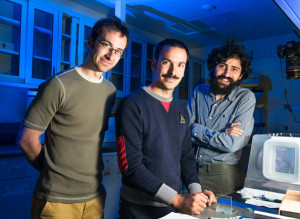
On March 11, a group of three Stanford researchers published a paper in “Nature” explaining a puzzling phenomenon: Under certain conditions, droplets of food coloring move and interact like small organisms – chasing, dodging and reacting to one another.
Nate Cira M.S. ’13 Ph.D. ’17, the lead author of the paper, first observed this phenomenon as an undergraduate at the University of Wisconsin. While working on an unrelated experiment, he deposited droplets of food coloring onto a glass slide and was amazed when they began to move freely along the glass.
This incident inspired Cira to study the phenomenon by himself for two more years before beginning graduate school at Stanford. He then shared his observations with Manu Prakash – senior author of the paper and assistant professor of bioengineering.
Cira and Prakash were also joined by Adrien Benusiglio – a postdoctoral scholar in Prakash’s lab and co-author of the paper. The researchers spent the next three years performing increasingly precise experiments to learn how the droplets of food coloring sense one another and move.
According to the researchers, the droplets mimic processes, called chemotaxis, where living cells sense one another and move accordingly.
“We have discovered how droplets can exhibit behaviors akin to artificial chemotaxis,” Prakash said.
This artificial chemotaxis is possible with food coloring because it is a two-component fluid comprised of propylene glycol and water. Two-component fluids are fluids in which two chemical compounds are present but maintain separate molecular identities.
The droplets move because of the differing surface tensions and evaporation rates of the propylene glycol and water in the food coloring.
Water has both a higher surface tension and faster evaporation rate than propylene glycol. This difference leads to a tornado-like flow within each individual droplet, allowing a droplet to move along a surface and sense its neighboring droplets.
The evaporation of water also determines the direction of the droplets’ movement – as one droplet gives off gaseous water molecules, the other droplets converge where this “cloud” is the strongest.
The paper also describes a “universal rule” to identify any two-component fluid that will demonstrate sensing and movement.
Though this information could prove useful in semiconductor manufacturing and self-cleaning solar panels, the researchers explained that this discovery is more impressive as a demonstration of their commitment to solving a scientific curiosity.
Contact Allegra McComb at amccomb ‘at’ stanford.edu
